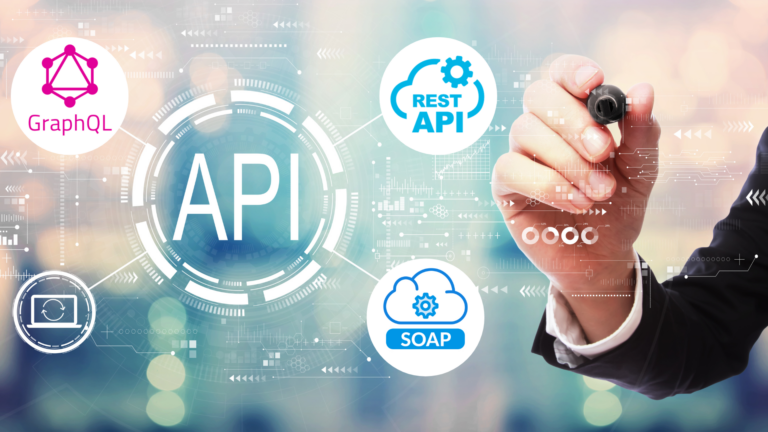In today’s interconnected digital landscape, where countless software systems and applications constantly communicate and exchange data, efficient and standardised interaction methods have become paramount. This is where APIs, or Application Programming Interfaces, come into play. APIs serve as the bridge that enables seamless communication and data exchange between different software systems, allowing them to work together harmoniously. In this article, we will explore the world of APIs, what they are, how they work, and their significance in modern technology.

Table of Contents:
- What is an API?
- Defining API as a set of rules and protocols for software system interaction.
- The analogy of an API is a restaurant waitperson.
- The Components of an API
- Exploring the request and response structure.
- Common HTTP methods used in API interactions.
- Authentication and security mechanisms in APIs.
- How Does an API Work?
- Client-server architecture and API endpoints.
- Requesting actions and processing responses.
- Data formats in APIs, with a focus on JSON.
- API Protocols
- Overview of popular API protocols:
- REST (Representational State Transfer)
- SOAP (Simple Object Access Protocol)
- GraphQL
- Overview of popular API protocols:
- API Documentation
- The importance of well-documented APIs for developers.
- Standardized documentation formats.
- The Benefits of API
- Enhanced Efficiency and Scalability.
- Seamless Integration and Interoperability.
- Accelerated Development and Innovation.
- Real-World Examples of API Usage
- Use cases of APIs in social media, payment gateways, and weather data.
- API Limitations and Challenges
- Considerations like rate limiting, security concerns, and versioning.
- Future Trends in APIs
- API economy and monetization.
- APIs in the Internet of Things (IoT).
- Integration of AI and machine learning capabilities.
- FAQs
- Answers to common questions about APIs, including their use cases, complexity, cost, and accessibility.
What is an API?
At its core, an API is a set of rules and protocols allowing software systems to interact. It acts as an intermediary between different applications, enabling them to share data, functionality, and services. Think of an API as a waitperson in a restaurant who takes orders from customers (applications) and communicates them to the kitchen (server) to fulfil those orders.
An API defines how a request from one software system should be structured and what kind of response should be expected. It serves as a contract between the client (requesting system) and the server (providing system), outlining the rules of engagement. APIs can be likened to a language that applications use to communicate with each other.
The Components of an API
To understand how APIs work, it’s essential to familiarise ourselves with their components. Firstly, APIs rely on a request and response structure. The client sends a request to the server, specifying what action it wants to perform or what data it requires. The server then processes the request and sends back a response containing the requested data or the outcome of the requested action.
HTTP methods play a crucial role in API interactions. The most common methods are:
GET: Retrieves data from the server.
POST: Sends data to the server to create new resources.
PUT: Updates existing resources on the server.
DELETE: Removes resources from the server.
Additionally, APIs incorporate authentication and security mechanisms to ensure that only authorised users or systems can access and interact with the provided services. This is typically done using API keys, tokens, or other authentication protocols.
How Does an API Work?
APIs operate on a client-server architecture, where the client is the system making the request, and the server is the system providing the requested service or data. To interact with an API, the client needs to know the API’s endpoint, which is a specific URL that indicates where the API can be accessed. The endpoint represents a specific resource or functionality provided by the server.
To perform an action using an API, the client sends a request to the specified endpoint. The request includes all the necessary information, such as the desired action, required parameters, and authentication details. The server processes the request, performs the necessary actions, and generates a response, which is then sent back to the client.
APIs are versatile and can be used to access various types of data formats. The most common data format used in modern APIs is JSON (JavaScript Object Notation). JSON is lightweight, easy to read, and widely supported across different programming languages. However, APIs can also use other formats like XML, CSV, or YAML, depending on the system’s requirements or compatibility.
API Protocols
Different APIs adhere to various protocols, which govern how they are designed and operated. The most popular API protocols are:

-REST (Representational State Transfer): REST is an architectural style defining constraints for building APIs. It emphasises simplicity, scalability, and statelessness. REST APIs use standard HTTP methods (GET, POST, PUT, DELETE) to perform actions on resources. They are widely used and have become the de facto standard for web-based APIs.
-SOAP (Simple Object Access Protocol): SOAP is a protocol that defines a standardised format for exchanging structured information using XML. SOAP APIs are more complex than REST and require explicit specifications for each API call. They are commonly used in enterprise environments where strong security and reliability are paramount.
-GraphQL: GraphQL is a relatively new API query language and runtime that allows clients to request specific data structures and minimise the amount of data transferred. With GraphQL, clients can request precisely what they need, avoiding the problem of over-fetching or under-fetching data.
API Documentation
Well-documented APIs are essential for developers who want to integrate and utilise them effectively. The API documentation provides comprehensive instructions on how to interact with an API, including the available endpoints, required parameters, request and response formats, and any authentication requirements.
Several popular documentation formats, such as Swagger, API Blueprint, and OpenAPI, provide standardised ways to document APIs. They enable developers to quickly understand how to consume an API, reducing the learning curve and accelerating development.
The benefits of API
-Enhanced Efficiency and Scalability:
Businesses and developers can tap into a vast ecosystem of pre-built functionalities and services by leveraging APIs. This eliminates the need to reinvent the wheel, saving valuable time and resources. APIs also facilitate scalability, enabling applications to handle increased user loads and seamlessly adapt to evolving business requirements.
-Seamless Integration and Interoperability:
APIs bridge disparate systems and applications, enabling them to communicate and exchange data effortlessly. This fosters integration and interoperability, allowing organisations to combine the strengths of different software solutions and create powerful synergies.
-Accelerated Development and Innovation:
APIs catalyse innovation by offering developers access to cutting-edge technologies and functionalities. For instance, by leveraging APIs for machine learning, developers can harness the power of advanced algorithms and data analytics, unlocking new possibilities and creating intelligent applications.
Real-World Examples of API Usage
APIs are ubiquitous in today’s digital landscape, and they power many of the services and platforms we use daily. Let’s explore a few real-world examples of API usage:
Social media APIs: Platforms like Facebook, Twitter, and Instagram provide APIs that enable developers to integrate social features into their applications. These APIs allow users to authenticate with their social media accounts, share content, and retrieve user data.
Payment gateway APIs: Companies such as PayPal, Stripe, and Braintree offer APIs that facilitate secure online payments. Developers can integrate these APIs into e-commerce platforms to enable smooth and secure transactions.
Weather APIs: Weather data providers like OpenWeatherMap and Weatherbit offer APIs that provide real-time and forecast weather information. Developers can leverage these APIs to display weather data in their applications or build weather-related services.
These examples showcase the versatility and usefulness of APIs in various domains, empowering developers to enhance their applications with external functionalities.
API Limitations and Challenges
While APIs bring numerous benefits, they also have some limitations and challenges that developers need to consider:
-Rate limiting: API providers often impose rate limits to prevent abuse and ensure fair usage. Developers need to manage and respect these limits to avoid being blocked or throttled by the API provider.
-Security concerns: APIs can be vulnerable to security threats such as unauthorised access, data breaches, and injection attacks. Developers must implement proper security measures, including encryption, authentication, and input validation, to protect sensitive data and prevent attacks.
-Versioning and backward compatibility: APIs evolve over time, and new versions may introduce changes or deprecate certain features. Developers need to handle versioning and ensure backward compatibility to avoid breaking existing integrations.
Future Trends in APIs
The world of APIs is constantly evolving, and several trends are shaping their future:
API economy and monetisation: APIs are becoming valuable assets organisations can monetise. Companies are increasingly creating API ecosystems and charging for access to their services, providing new revenue streams and business models.
Internet of Things (IoT) and APIs: As the IoT expands, APIs play a vital role in connecting and integrating IoT devices. APIs enable communication and data exchange between devices, unlocking the potential of smart homes, connected cars, and industrial automation.
AI and machine learning integration: APIs facilitate integrating artificial intelligence and machine learning capabilities into applications. Developers can leverage APIs to access pre-trained models, natural language processing, image recognition, and other advanced AI functionalities.
These trends demonstrate that APIs will continue to evolve and significantly drive innovation and digital transformation across various industries.
In conclusion, APIs are the backbone of modern software systems, enabling seamless communication, data exchange, and application integration. They act as the glue that connects different services, platforms, and devices, allowing them to work together harmoniously. Understanding the fundamentals of APIs, their components, and how they operate is essential for developers and businesses alike. As technology advances and new trends emerge, APIs will continue to shape the digital landscape, empowering developers to create innovative and interconnected solutions.
FAQs
FAQ 1: Can APIs only be used for web development?
No, APIs can be utilised in various domains beyond web development. They are commonly used in mobile app development, desktop applications, IoT devices, and more. APIs enable software systems to communicate and exchange data regardless of the platform or technology involved.
FAQ 2: Are APIs only relevant for large enterprises?
No, APIs are relevant for businesses of all sizes. While large enterprises may have more extensive API ecosystems, even small businesses can benefit from APIs. They provide access to valuable services, functionalities, and data sources that can enhance applications and improve business processes.
FAQ 3: Is API integration complex?
API integration can vary in complexity depending on the specific API and the complexity of the integration requirements. However, with well-documented APIs, development resources, and frameworks, API integration has become more accessible and manageable for developers with different levels of expertise.
FAQ 4: Are APIs free to use?
API availability and pricing models vary. Some APIs are provided free of charge, while others have usage limits or require subscription plans. Additionally, certain APIs offer freemium models, where basic access is free, but premium features or higher usage thresholds incur costs. It’s essential to review the API documentation and terms of use to understand the pricing structure.
FAQ 5: Can APIs be used without programming knowledge?
Utilising APIs typically requires programming knowledge to interact with the API endpoints, handle responses, and integrate them into applications. However, there are low-code or no-code platforms and tools available that provide graphical interfaces for API integration, allowing users with limited programming knowledge to leverage APIs in their applications.


